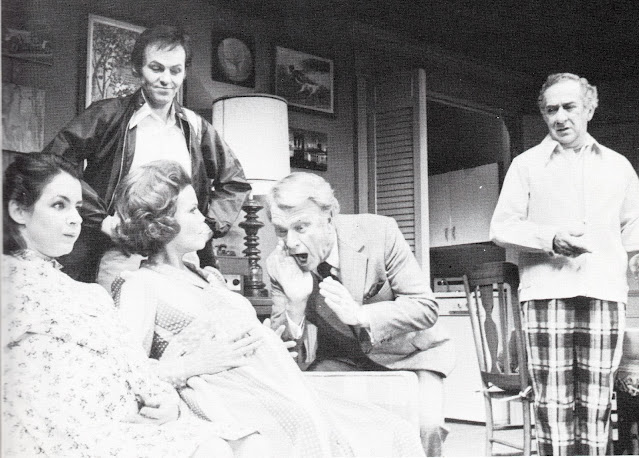 |
| Roderick Cook, Jamie Ross, Barbara Cason. |
OH COWARD! [Musical Revue] M/LY: Noël Coward; D: Roderick Cook;
S: Helen Pond and Herbert Senn; P: Wroderick Productions, Inc.; T: New Theatre
(OB): 10/4/72-6/17/73 (294)
English playwright-actor Roderick
Cook, a Noël Coward specialist, devised, directed, and performed in this
sparklingly tasteful, intelligent, and deceptively simple Off-Broadway revue of
the master’s songs and jottings. Cook had originated it for the Vancouver
International Festival in 1968, titled And Now Noël Coward . . . An
Agreeable Impertinence, and starring Dorothy Loudon. After negative critical
response, it was reworked for Broadway and called Noël Coward’s Sweet
Potato, opening on September 29, 1968, and garnering 44 performances. Cook revised it again as Oh Coward!, produced in in Toronto and elsewhere, and then brought it to Off
Broadway in this production.
With a modest accompaniment from
twin pianos and a drum, the two-man (Cook and Jamie Ross), one woman (Barbara
Cason), formally-garbed cast provided a spot-on interpretation of Coward’s
stylish sophistication and verbal marksmanship, with every chiseled word
precisely spoken, and every tuneful note sung with clarity and charm. Even the
curtain, showing a double-headed caricature of Coward, one face a bit sour, the
other slightly smiling, contributed to the overall effect.
So aptly was it done that the lack
any particularly noteworthy voice—Mel Gussow thought Ross the best singer—was
of secondary concern. The spoken passages were plucked from Coward’s plays and
books, most of the songs from his shows. A few songs—like Cole Porter’s “Let’s
Do It”—had been sung by Coward although someone else wrote them.
Among the many musical numbers—created
over 38 years—were “Something to Do with Spring,” “Ziegeuner,” “We Were
Dancing,” “Sail Away,” “Room with a View,” “If Love Were All,” “Mrs.
Worthington,” “Mad Dogs and Englishmen,” “Gertie,” “Mad about the Boy,”
“Someday I’ll Find You,” and “I’ll See You Again.”
Oh Coward! was
played straight. Gussow reported, “Wisely, Mr. Cook and his companions play
everything tight to the chest. They barely crack a smile, even when laughing—but
we laugh. Nothing is spoofed or ridiculed. There is no overstatement or
overproduction. . . . ‘Oh Coward’ lets Sir Noel speak for himself.” John Simon
referred to the approach as a perfect example of “high camp,” meaning
“subversive or even anarchic views given the most genteel and soigné
expression.” He thought the revue “a small diamond, but . . . a very nearly
flawless one.” Like several others, he made special note of the originality of Cook’s interpretation of the song, “The Party’s Over Now,” from Words and Music, long associated with
Beatrice Lillie’s eccentric rendition. Here, though, it was proffered as the
unhappy remembrance of a man suffering the aftereffects of a “marvelous party”
that was anything but “marvelous.”
Oh Coward! subsequently played in
London, and, in 1986, was revived at Broadway's Helen Hayes Theatre for 56 performances,
earning Tony nominations for Cook and Catherine Cox.
















































